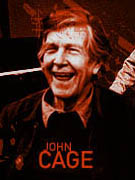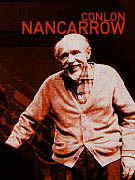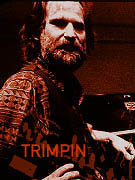 |
||
|
|
 |
|
| If you build it, they will come! |
|
California composer John Cage spent the 1930s writing music for percussion. Even though he wasn't the only one doing it, he became rather notorious for it. In fact, the March 15, 1943 issue of Life magazine ran a bemused two-page spread on Cage's percussion orchestra. "At the Museum of Modern Art in New York City a few Sundays ago," the article began, "an orchestra of earnest, dressed-up musicians sat on the stage and began to hit things with sticks and hands. They whacked gongs, cymbals, gourds, bells, sheets of metal, ox bells, Chinese dishes, tin cans, auto brake drums, the jawbone of an ass and other objects.... The audience, which was very high-brow, listened intently without seeming to be disturbed at the noisy results." And to further explain Mr. Cage's apparent madness, the writer added, "Percussion music goes back to man's primitive days when untutored savages took aesthetic delight in hitting crude drums or hollow logs. Cage believes that when people today get to understand and like his music, which is produced by banging one object with another, they will find new beauty in modern life, which is full of noises made by objects banging against each other." Margaret Leng Tan prepares the piano John cage style Many of America's maverick composers have become inventors. The cultured music we inherited from Europe, and even the musics that have been brought here from Asia and Africa, have not always been sufficient for the needs of democratic, commercial, noisy, fast-paced America. The oboe, the piano, the violin cannot always play the music we Americans hear in our heads. And so we improvise. Artistic necessity becomes the mother of musical invention. Some of America's maverick composers have even been called inventors in a derogatory way. In a 1926 article Aaron Copland called Henry Cowell "an inventor, not a composer." Echoing that remark, several years later Arnold Schoenberg would say that his student John Cage was "not a composer, but an inventor—of genius!" Somehow, in the world of the symphony orchestra hall and music conservatory, to be a musical inventor is not to be a composer at all. But Henry Cowell was an inventor. As a teenager he played the piano keyboard with his fists and forearms, crashing down on many continuous notes at once: the cluster chord. It turned out that Charles Ives had already invented the cluster chord a few years earlier, but no matter: Cowell had other inventions. He was the first to play the piano by strumming the strings. He was the first to run his fingernail along a piano string, making a weird cry like a wailing ghost. Most significantly of all, in his early book New Musical Resources he invented a new approach to rhythm that divided the measure up into many different equal divisions to allow for several tempos to be played at once. At the age of 20, he wrote a piece rather ironically titled Quartet Romantic, for two flutes, violin, and viola, illustrating his theories. The piece opens with the instruments playing polyrhythms of 4 against 5 against 6, then moves to tempos of 16 against 27 against 36 against 45, and so on. Nearly unplayable, the piece lay unheard until 1978, when it was recorded by four performers listening through headphones to clicktracks marking off their diverse tempos.
|
||||||||||
|
One of the things Cowell mentions in his book is that, while these rhythms may be impossible to play for human performers, "these highly engrossing rhythmical complexes could easily be cut on a player-piano roll. This would give a real reason," he continues, "for writing music specially for player-piano, such as music for it at present does not seem to have." Conlon Nancarrow read that passage in about 1939. Born in Arkansas, he had joined the Communist Party in college and was just homing from fighting in the Spanish Civil War in the Lincoln Brigade. He came home to New York, bought Cowell's book, and then found out that his friends in the Brigade were starting to be hassled by the government because of growing paranoia about Communists. Refusing to go through the coming McCarthy-era mess, he took off for Mexico City in 1940, and lived there the rest of his life, until 1997. In 1947 Nancarrow inherited some money from his father, who had been mayor of Texarkana. He took a trip to New York and bought a player piano, and had a machine built for him to punch rolls with. Unlike Cowell, who never tried his player-piano experiment, Nancarrow took off. He had never been able to play the piano, and he loved jazz, so his first piano rolls sounded like three extremely fast Art Tatums all playing at once. Like Cowell before him but freed to endless possibilities by his mechanical resource, Nancarrow became fascinated by different tempos going at the same time. Eventually he started exploring this effect via the tempo canon, a form in which the same melody would be played against itself in different speeds at once. As he continued, Nancarrow found that the player piano was not simply a rhythmically accurate substitute for a human pianist. It was capable of textures and riffs and speeds that no human could ever play. For decades Nancarrow worked out his series of 50 player piano studies in isolation in Mexico City. In the late 1970s, however, thanks to curious researchers like Peter Garland and Charles Amirkhanian, publicity began to seek out Nancarrow's innovations, and he began getting interest from human performers willing to tackle his rhythmic difficulties. And some of the player piano studies were orchestrated for a live ensemble of musicians who, during the decades of Nancarrow's isolation had learned to play the polyrhythms he was so fascinated by.
Harry Partch read Henry Cowell's book, too. The part that impressed him wasn't so much the part on rhythm as on the theory of pitch. Cowell used the harmonic series, the pattern of overtones you get from evenly subdividing a vibrating string, as justification for future harmonic directions, and predicted that we would someday use smaller and smaller intervals. Partch had already been reading the classic 1885 text on musical acoustics On the Sensations of Tone by the German scientist Hermann Helmholtz. Helmholtz (who also made a big impact on Debussy and other composers), demonstrated that the musical intervals we use on the piano today are only approximations of the true, consonant intervals provided by nature. Partch gnawed away on this thought for years. Then finally, one day passing through New Orleans on his interminable travels, he put all the compositions he had written in a big pot-bellied stove and burned them. It was 1930. He was 29. And
he was not going to put up with the lie of European tuning another minute.
In 1950 Partch received a visitor, a young man who had come to work with him: Ben Johnston. Born in Macon, Georgia, in 1926, Johnston was not much of a carpenter and wasn't much help with Partch's instruments, but he was the first assistant Partch had ever had who instinctively understood what Partch was trying to do in the realm of tuning, and who could himself produce the pitch relationships Partch wanted. Johnston had found out about Helmholtz at the age of 11, and by the time he was 18 he predicted in an intervew that "with the clarification of the scale which physics has given to music there will be new instruments with new tones and overtones." Not until 1960, though, did Johnston begin writing in a system of tuning he calls "extended just intonation." To write different tunings for conventional instruments, he needed a new notation. So he invented one. In addition to the usual sharps and flats it has little sevens and upside-down sevens for seventh overtones and undertones, little arrows pointing upward and downward, little 13s and 17s and so on for even higher harmonics. Some of Johnston's music is for retuned piano, and is no more difficult to play than any normally tuned music, such as this Suite for Microtonal Piano from 1977, with the entire keyboard tuned to harmonics of C. Johnston has also excelled at the string quartet, having added ten such pieces to the repertoire. His best-known and most popular work is his Quartet No. 4, subtitled "Amazing Grace." By the end of the work it has racked up 22 pitches to the octave, and yet it stays so close to one of America's best-loved tunes that the strange tuning, if noticed at all, remains in the background. One of Henry Brant's inventions has never been built. It's a concert hall with movable walls, and he likes to proudly show off a model of it. Brant, who turns 90 this year, has been the leading pioneer of "spatial music"—that is, music written for performers and even ensembles scattered around a large area. From the very beginning Brant demonstrated an unusual sensitivity to sound, and he was among the first to use nonmusical objects in his pieces. At the age of 19 he wrote Music for a Five and Dime, scored for Eb clarinet, piano, and kitchen hardware. He soon followed this up with a piece called The Marx Brothers (three portraits titled "Chico," "Groucho," and "Harpo") in which Brant's own instrument at the time, the tin whistle, is accompanied by chamber ensemble. Brant started writing extensively for multiples of one instrument: his Consort for True Violins uses violins of different sizes, while Angels and Devils is for three piccolos, five normal flutes, and two alto flutes. In 1953 he started writing spatial music, and his arrays of ensembles have continued expanding since that time. He's written Orbits, for 80 trombones, organ, and "sopranino" voice. There is Fire on the Amstel for four boatloads of 25 flutes each, four jazz drummers, four church carillons, three brass bands, three choruses, and four street organs. His The Immortal Combat for different instrumental groups, when it was performed on the outdoor plazas and balconies of Lincoln Center, was drowned out by traffic noise, a fountain, and a thunderstorm. A 1992 performance of 500: Hidden Hemisphere, written for the Columbus quincentennial, combined three military bands and steel band outside Lincoln Center with much better results. Nevertheless, Brant has worked to develop acoustic instruments with the power of tugboat whistles, loud enough to drown out even an urban environment. Brant's reason for separating his groups of instruments is to be able to use more contrapuntal lines at once and still allow the ear to distinguish them. It's a little bit like the problem pilots have with all the verbal information they get while they're trying to land a plane; their headsets have to diversify all the verbal signals in different spaces so they can hear them and keep them separate. "I tried writing eight or ten simultaneous, contrasted, contrapuntal lines," Brant has said, "...with the musicians all placed together, as usual. I found that I was running into trouble: The musicians could play the notes all right, but you really couldn't identify the details in the compound result.... But there didn't seem to be a necessary reason why music should be limited to even twelve horizontal events at once. Why not more than twelve? The ear never said, "I refuse to listen." Most recently, Brant won the Pulitzer Prize for his orchestral work Ice Fields. Brant designed his concert hall with movable walls to be able to change its acoustical shape to fit nearly any layout of performers a composer could visualize. The project is extremely expensive, and no one has taken him up on it. But at 90, the enthusiastic old inventor is still explaining it to people, and still making his music larger and larger in scope. Henry Brant
|
||||||||||
|
Another inventor also has a dream, and a long record of turning his dreams into astonishing realities. In 1980, an inventor named Trimpin—and that's the only name he uses—moved to Seattle, Washington, from Germany because, as he says, America has better junkyards than Europe. Trimpin invents machines to make music, but unlike most composers who use electronics, he uses them to make acoustic music. He has invented devices which will play virtually every instrument of the orchestra via computer MIDI commands. His stringed instruments use levers to bow cellos and pegs to finger the fingerboard. His MIDI-triggered clarinets use pumps to force air through reeds. His MIDI xylophones tap away upon digital commands. His mechanical timpani mallet cannot only strike the timpani, but rub the surface faster than human hands can do and actually create a timpani drone. But conventional instruments are only part of Trimpin's story: upon MIDI commands, water drips from buckets in complex polyrhythms, duck calls spin a ripple of squawks around the room, notes zip up and down staircases with lightning speed. Trimpin's father was a brass and woodwind player, and as a child, growing up on the Swiss/French/German border, Trimpin had access to old instruments he could cut up and exchange the parts of. At 10 or 12 he would go to the junkyard and stack up old short-wave radios, risking his life by hooking them up to electricity and antennas, then turning the knobs in-between stations for static. Declared incapable of learning by his early teachers because his mind ran in such strange channels, he studied metal work and electronics. In his music therapy class, he invented a light-sensitive keyboard that handicapped patients could play by moving a light pencil with their mouths. Trimpin moved to America because his inventions were expensive to make, and here he could find thousands of junked computer parts, ribbon cable, old musical instruments. One of his first installations since moving here was a microtonal xylophone six stories high running through the center of a spiral staircase, with computer-driven melodies ripping up and down it at lightning speed. Another was an installation of water fountains dripping into glass receptacles, the drips digitally timed in complex rhythmic fugues. He has sent bass drums, beaten by mechanical mallets, traveling across the room suspended from tracks on the ceiling. Another project is a gamelan with iron bells suspended in air by electronic magnets; when they rise to a certain point, the circuit is broken by a photo sensor, keeping the bell in an oscillating stasis in which, since they don't touch anything, they will ring with a phenomenally long decay. Trimpin has made a fire organ, with glass pipes made to vibrate by Bunsen-burner flames that send hot air rising through them. Until the year 2000, Trimpin had never used an electronic sound in a work. He doesn't like the way loudspeakers are designed. "...this big magnet with a magnetic coil and a physical membrane," he says."It's laughable. Digitally, every detail gets recorded, but the output lacks the resonance of the instrument. The future of loudspeakers is a different design that resembles more the acoustic resonance of instruments." But in 2000, Trimpin agreed to create a permanent installation, a towering tornado of electric guitars, for the Experience Music Project in Seattle, a building designed by Frank Gehry as a kind of rock and roll museum, and specifically an homage to Seattle native Jimi Hendrix. 650 guitars hang from a flared cylinder 35 feet high. Some of the guitars are just for looks, others have their strings struck and strummed in precisely synchronized rhythms snaking spatially around the tornado. When Trimpin first proposed the design, the honchos wanted to know who was going to climb that tornado and tune all those guitars. But Trimpin, with his typical all-seeing engineer's vision, had already anticipated them. At the bottom of each guitar is a tuning sensor. The computer self-tests, and if the string goes more than a couple of cents flat, the tuning sensor will activate a screw that will extend the movable top of the guitar's neck slightly, stretching out the string until it is again perfectly in tune—a self-tuning guitar. "Yankee inventiveness" is a phrase we don't hear much anymore. Perhaps it's become so ubiquitous a concept in the digital age that we no longer notice it. But America's young composers continue inventing away. Most interesting is often what they do with low-tech and discarded machines. Nic Collins, now teaching at the School of the Art Institute in Chicago, plays a trombone with a loudspeaker inside it, with keys attached that hook up via cables to a computer. Collins flicks a finger, and the prerecorded samples issuing from his trombone switch from Peruvian band songs to human speech to electronic noises. David Weinstein and his orchestra, called Impossible Music, play CD players that have been hot-wired to bypass the usual functions, so they can play CDs the way a string quartet plays violins—looping, interrupting, jumping around. John Morton has invented assemblages of music boxes, up to 17 at a time, running their independent cycles like an African percussion ensemble who've lost their way. All of this invention has helped free the present-day composer from the institutions of the symphony orchestra, the concert hall, the opera house, and created a grass roots musical society that can operate freely within America's economic realities—a subject we'll address in a future episode of American Mavericks™.
|
||||||||||
 |
|||||
| American Mavericks | Archive | About | Contact | Stations | Features | Press | Listening Room | Discussion | Purchase | |||||





